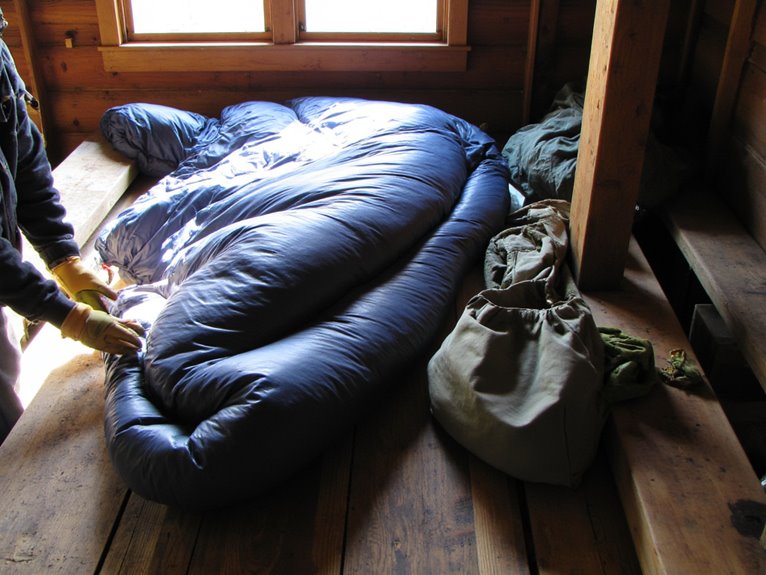How to Pack a Sleeping Bag Without Losing Loft
To pack your sleeping bag without losing loft, verify it’s completely dry and shake it to redistribute insulation evenly before compression. Use gentle stuffing techniques rather than tight rolling, which can damage down fibers and reduce loft retention from 95% to just 75%. Choose compression sacks with adjustable straps and air purge valves for controlled pressure distribution. Systematically push air from foot to head opening, avoiding sudden force or aggressive pulling motions that compromise structural integrity and permanently damage insulation properties over time.
We are supported by our audience. When you purchase through links on our site, we may earn an affiliate commission, at no extra cost for you. Learn more. Last update on 10th December 2025 / Images from Amazon Product Advertising API.
Notable Insights
- Use gentle stuffing or sleeve rolling techniques instead of tight rolling or vacuum compression to maintain 90-95% loft retention.
- Ensure the sleeping bag is completely dry before packing and systematically remove air pockets without using excessive force.
- Choose compression sacks with adjustable straps and air purge valves for controlled, even pressure distribution during packing.
- Avoid keeping sleeping bags compressed for extended periods; use compression sacks only temporarily during transport.
- Store uncompressed in breathable cotton or mesh sacks in cool, dry environments to preserve insulation integrity long-term.
Preparing Your Sleeping Bag for Compression
Success in compressing your sleeping bag starts with proper preparation before you even touch the compression sack.
Begin with thorough bag maintenance tips by checking for damage, tears, or moisture that could compromise insulation performance. Confirm your bag is completely dry. Even minimal dampness reduces loft by 20-30% and promotes mildew growth.
Minimal dampness reduces sleeping bag loft by 20-30% and promotes mildew, so ensure complete dryness before compression.
Conduct a fill material inspection by gently shaking the bag to redistribute down or synthetic insulation evenly throughout all chambers. Clumped fill creates cold spots and uneven compression.
Clean any dirt or debris from the shell fabric, as particles can puncture delicate materials during compression.
Remove excess air by gently pressing sections of the bag. This preliminary step prevents over-pressurization of seams during compression and makes the rolling process more manageable and effective.
Consider securing any loose insulation with safety pins to prevent fill migration during the compression process, which helps maintain even distribution and thermal performance.
Choosing the Right Compression Tools and Equipment
While preparation sets the foundation for effective compression, your choice of compression tools directly determines how efficiently you’ll reduce your sleeping bag’s packed volume and maintain its long-term performance.
Different compression sack types offer varying benefits for specific applications. Rectangular compression sacks provide 20% better packing efficiency than traditional round designs through superior space utilization. Waterproof options protect down insulation from moisture damage that destroys loft permanently.
Look for adjustable compression straps that distribute pressure evenly across your sleeping bag. Quality models feature 3-4 straps with mechanical advantage systems.
Air purge valves eliminate trapped air efficiently during compression. Choose materials like 30D diamond ripstop cordura nylon for durability without weight penalties.
Down sleeping bags require gentler compression than synthetic fills to preserve delicate loft structure. Premium models using 210T tear-resistant polyester with double-reinforced seams offer superior durability while maintaining the lightweight characteristics essential for backpacking.
Proper Folding and Rolling Techniques
You’ve got two primary methods for packing your sleeping bag: folding and rolling, each with distinct advantages for different situations.
Folding creates a compact rectangular shape that fits well in structured packs, while rolling produces a cylindrical form that’s easier to stuff into tight spaces.
The key to both techniques lies in systematically removing air pockets, which can reduce pack volume by up to 30% and prevent uneven compression that damages insulation fibers.
Just as with sleeping pads, avoid tight compression for extended periods to prevent permanent damage to your sleeping bag’s insulation properties.
Folding Vs Rolling Methods
Most backpackers face a fundamental choice when packing their sleeping bag: folding or rolling. Each method offers distinct advantages and disadvantages depending on your gear and circumstances.
Rolling provides superior space efficiency and distributes stress evenly across materials. You’ll achieve tighter compression and faster packing times. Rectangular bags roll easier than mummy styles.
However, rolling disadvantages include potential zipper stress if not properly aligned and difficulty achieving consistent compression.
Folding advantages include precise control over compression points and easier handling of mummy bags. Synthetic fills tolerate folding better than down.
Yet folding creates repetitive stress lines that weaken materials over time. These permanent creases reduce loft in critical insulation zones.
Down bags require gentler handling regardless of method. Over-compression damages delicate fill permanently, reducing thermal efficiency greatly.
Minimizing Air Pockets
Regardless of whether you fold or roll your sleeping bag, eliminating air pockets determines the difference between efficient compression and wasted pack space.
Air pocket prevention requires systematic technique rather than brute force.
Start by gently pushing air from the foot toward the head opening. Rotate the bag continuously during stuffing—this distributes seam stress evenly and prevents material bunching.
Never jump on or yank compression straps rapidly, as sudden force damages internal baffles and exterior seams.
Use your body weight for controlled compression instead of aggressive pulling motions. Push remaining air through the opening before cinching your compression sack closed.
This efficient packing method reduces volume by 40-60% while maintaining insulation integrity. Regular inspection guarantees your technique isn’t compromising the bag’s structural components over time.
Safe Compression Methods to Preserve Insulation
When compressing your sleeping bag, you’ll need to apply pressure gradually and evenly to prevent damaging the insulation fibers.
Start with gentle pressure on one section, then work systematically around the bag to distribute compression forces uniformly across all areas.
This methodical approach protects both down and synthetic fills from localized stress points that can permanently reduce loft and thermal performance.
Use body weight for final compression rather than aggressive force, as this provides controlled pressure that maintains insulation integrity while achieving optimal pack size.
Gentle Pressure Application Techniques
Although sleeping bags withstand considerable compression during transport, applying pressure incorrectly can permanently damage the insulation and reduce thermal performance. Gentle handling with awareness of pressure limits prevents fiber breakdown in both down and synthetic fills.
Reserve compression for travel only, not storage. Excessive force crushes delicate fibers and reduces loft permanently. Apply pressure gradually to distribute force evenly across the insulation.
| Do | Don’t |
|---|---|
| Use compression only during trips | Store bags compressed long-term |
| Apply gradual, even pressure | Over-compress beyond manufacturer limits |
| Allow full loft before packing | Force bags into undersized stuff sacks |
| Use breathable storage materials | Keep bags permanently compressed |
| Inspect regularly for damage | Ignore pressure limit specifications |
Temporary compression methods work best when you allow the bag to achieve full loft before packing.
Even Compression Distribution Methods
Proper compression distribution protects your sleeping bag’s insulation while maximizing pack efficiency.
Use compression sacks with adjustable straps for better control over pressure application. These sacks reduce your bag to half its original size or less.
Stuff the bag one handful at a time using both hands. Pull the compression sack upward while stuffing to prevent insulation clumping. This technique guarantees compression efficiency throughout the process.
Pivot the sack as you progress to spread bulk evenly. Support with one hand while stuffing with the other. Use fists to push material down systematically.
Dedicate ultralight ditty bags for other gear, freeing main space for your sleeping bag. This insulation protection strategy prevents over-compression damage to down fill while maintaining proper loft distribution.
Maintaining Loft During the Packing Process
Since insulation’s loft directly determines your sleeping bag’s thermal performance, you’ll need to balance packing efficiency with preserving the material’s ability to trap air effectively. Understanding compression impact and proper insulation care prevents permanent damage to your bag’s thermal properties.
Apply gentle, incremental pressure when stuffing your bag. Start from the foot end and work systematically toward the head. This technique distributes stress evenly across baffles and prevents concentrated pressure points that damage insulation structure.
| Compression Method | Loft Preservation | Risk Level | Recommended Use |
|---|---|---|---|
| Gentle Stuffing | 95% retention | Low | Daily packing |
| Sleeve Rolling | 90% retention | Low | Extended trips |
| Tight Rolling | 75% retention | High | Emergency only |
| Vacuum Compression | 60% retention | Very High | Never recommended |
Monitor compression duration carefully. Extended compression accelerates loft loss in both down and synthetic fills. Ground contact compresses sleeping bag insulation and creates a thermal sink, which is why proper sleeping pads remain essential for maintaining your bag’s thermal effectiveness during use.
Storage and Transport Best Practices
While efficient packing gets your sleeping bag to the destination, what happens afterward determines whether it’ll maintain peak thermal performance for years or gradually lose its insulation capacity.
Your storage environment must provide cool, dry, and dark conditions. Avoid attics, basements, and garages where temperature fluctuations and dampness damage insulation. A climate-controlled closet offers ideal stability.
Pre storage preparation requires complete drying and debris removal. Shake and fluff the bag to maximize loft before placing it in a breathable cotton or mesh storage sack of at least 90 liters. Never store compressed or folded.
During transport, use compression sacks only temporarily. Remove immediately upon arrival and allow full expansion.
Protect from moisture and sharp objects that compress or tear materials.
Consider using a sleeping bag liner to reduce the frequency of washing your sleeping bag, which helps preserve the insulation’s integrity over time.





